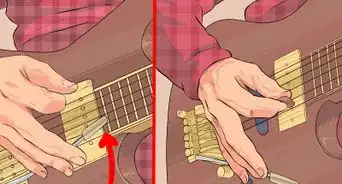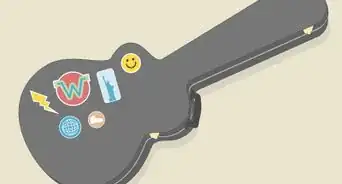This article was co-authored by Carlos Alonzo Rivera, MA. Carlos Alonzo Rivera is a guitarist, composer, and educator based in San Francisco, California. He holds a Bachelor of Arts degree in Music from California State University, Chico, as well as a Master of Music degree in Classical Guitar Performance from the San Francisco Conservatory of Music. Carlos specializes in the following genres: classical, jazz. rock, metal and blues.
There are 7 references cited in this article, which can be found at the bottom of the page.
wikiHow marks an article as reader-approved once it receives enough positive feedback. In this case, 80% of readers who voted found the article helpful, earning it our reader-approved status.
This article has been viewed 150,241 times.
A guitar capo is a versatile device that's used by guitarists around the world. The capo enables the musician to change the key of the chords that they are playing and can help singers synch their instruments with their voices. Guitar capos are also great tools for those having difficulty with more complex guitar chords that are further down the neck.[1] Using a capo enables the guitarist to create different tones with their guitar while using the same simplistic open chord shapes and forms that many guitarists learn when they first start playing.
Steps
Positioning the Capo on Your Guitar
-
1Place your capo on the desired fret. If you're using tabs or sheet music, you may also notice that it tells you to barre or capo a particular fret. Slide your capo over the desired fret and close it down. It should hold down all six or twelve strings on your guitar and act the same way your index finger acts when using barre chords.
- When starting off, it's a good idea to use your capo on the first to third fret, just to get an idea of how it affects your guitar's tone.
- Keep in mind how the capo will change the key, tone, and notes that you'll be playing.
-
2Tighten the capo close behind the fret. Tightening your capo in the middle of a fret can cause tension to be distributed unevenly across the neck. This can result in a buzzing or muted sound when trying to play your guitar. To prevent this from happening, make sure to tighten your capo as close to the edge of the fret on the side that's closest to the body of your guitar.Advertisement
-
3Tighten or loosen the screws on a screw capo. Screw capos are a popular style of capo that allow the musicians to fine-tune the capo's tension. This is especially useful if your guitar's neck is thick or you have a higher than normal action. While screw capos are accurate, they also have the drawback of taking longer to reposition. This may not be good for a live performance where you'll have to change your capo's position quickly from song to song.[2]
-
4Apply a trigger capo by squeezing and releasing the handles. Trigger capos are easy to adjust as you play. These capos rely on resistance to hold your strings down and don't require you to loosen screws or adjust straps. The downfall of trigger capos is that you can't adjust the capo's tension. This could result in a buzzing sound if the capo is too loose or could add unnecessary tension on the neck of your guitar and strings if it's too tight.[3]
- Trigger capos are often used in live performances because of the speed in which you can move it up and down the neck.
-
5Pull the strap to tighten the tension on a toggle capo. Toggle capos are small, lightweight capos that are tightened with a strap. Toggle capos are beneficial because of their size and the ability to carry them in your pocket. They are also much cheaper than other capos and can be purchased for under $10. The drawbacks are that toggle capos can break easily and don't always have the most precise tension due to the nature of the strap.
Playing With the Capo
-
1Tune your guitar. If your guitar is out of tune, it won't matter where you place the capo because the guitar will still sound bad. While there are different tuning configurations, the standard guitar tuning, from top string to bottom is, E, A, D, G, B, E. If you can't tune your guitar by ear, consider buying an electronic tuner that can help you get your tuning exact.[4]
-
2Learn to play open chords on your guitar. Before you start using a capo, make sure that you have the fundamental chord shapes down. Learn how to play the basic open chords like E minor and C before moving onto more complex open chords like D minor and G.[5] If you're already proficient at playing open chord progressions, then having a capo will increase your guitar versatility and you'll be able to make the transition much easier.
- Search for chord maps online or at a music store if you are having trouble playing a specific chord.
-
3Determine the key you're playing in when playing with others. If you are playing in a group, you'll all want to play in the same key so that your music sounds cohesive. There are seven chords for each key, and they correspond with the seven chords in each key scale. The capo position will change the chords you are playing, thus altering the key that you're playing in. Move your capo up and down the neck to change the key that you're comfortable playing in.
- The progression of chords within a scale takes the pattern of major, minor, minor, major, major, minor, and diminished.[6]
- Using this pattern, you can see that the chords in the key of C are C major, D minor, E minor, F major, G major, A minor, and B diminished.
- The progression of chords within a scale takes the pattern of major, minor, minor, major, major, minor, and diminished.[6]
-
4Use the capo to brighten the tone of the guitar. Using a capo further down on your neck will brighten the tone of your guitar and make it easier to write happy or upbeat music. Other than helping match your vocal registry, use the capo to make your open chords sound happier. Experiment with different positions further down the neck and see what kind of sounds you can create.
-
5Transpose your music using a capo. Look online for a transposition chart for guitars with capos. These charts will tell you exactly which chord you're playing depending on where your capo is positioned. Take some existing music you already know how to play and place the capo on a fret. Once you're done with that, correspond which chord shapes you need to use to match the chords you'd normally play without a capo.EXPERT TIPCarlos Alonzo Rivera is a guitarist, composer, and educator based in San Francisco, California. He holds a Bachelor of Arts degree in Music from California State University, Chico, as well as a Master of Music degree in Classical Guitar Performance from the San Francisco Conservatory of Music. Carlos specializes in the following genres: classical, jazz. rock, metal and blues.Professional Guitarist

 Carlos Alonzo Rivera, MA
Carlos Alonzo Rivera, MA
Professional GuitaristExpert Exercise: If you know the chords C and D minor in the normal position, you can use a capo on the second fret to play D major using the C shape and E minor using your D minor shape.
-
6Understand the music theory behind the capo. When you use a capo, you can use the same open chord shapes or forms, but the chord notes will be different depending on where you placed the capo. Much like a barre chord, the capo holds down all the strings on a particular fret. This means that the same chord shapes that you're used to playing in the open chord position will now emit different tones with the same finger positioning on the guitar's neck.
- Moving your capo up one fret will move your chord up a half step or half-tone, while moving the capo up on the guitar's neck for two frets will move it up a full step or tone.
- For example, a C form played with a capo on the first fret has now become a C#. The G chord form played with a capo on the first fret turns into a G#, moving the chord up one half-step.
- When moving the capo up to the second fret, your C form has now become a D and your G becomes an A, moving your chord up a full step.
Purchasing a Capo
-
1Determine which type of capo you want. There are a multitude of different capos that you can purchase online or at most music stores. Ask to try different capos at a music store to see which one you like the best. Determine if you'll be using the capo for live performances, or if you're just going to use it at home.
- If you're just using the capo at home during practice, a screw capo is the most durable and precise capo that you can get.
- If you're using the capo during live performances, consider using a trigger capo because of how quickly can you adjust it on the neck.
-
2Compare prices for capos online. Capos range in price. Determine how much money you're willing to spend on this accessory before going over your options. If you're a new guitar player or have never used a capo in the past, you may want to go with a cheaper version, to see if you like using one. If you are a veteran guitar player and know that you enjoy using one, opt to go with a higher-quality capo.
- The average cost of a guitar capo is anywhere between $4 to $30 depending on the style and quality.[7]
-
3Order your capo online or purchase one at a music store. Once you determine the capo that you want, go to an online music store or visit a physical location near you. Visiting the physical location could be beneficial because often they will allow you to test your equipment there. This could be especially valuable if you've never used a capo before.
- Popular capo brands include Shubb, Neewer, Live for Music, and Jim Dunlop.
- Popular music stores include Sam Ash, Guitar Center, Truetone Music, and Dream Guitars.[8]
Community Q&A
-
QuestionI am a beginner. What if the capo is in the way when I'm trying to play a chord? Like suppose there's a capo on fret 2 and the chord is D. How'll this work?
 Community AnswerYou act like the fret directly below the capo is the first fret and form D normally, using the capo as the 0 fret. The fret right after the capo is fret 1.
Community AnswerYou act like the fret directly below the capo is the first fret and form D normally, using the capo as the 0 fret. The fret right after the capo is fret 1. -
QuestionWhen we put the capo on my daughter's guitar, the chord schemes all sound the same. Ie. it doesn't sound any different when she strums the G, C, or D? What are we doing wrong? We have the Kyser brand clothes pin/spring type. She has an acoustic guitar.
 Community AnswerMake sure that it sounds exactly the same and that the tone of the guitar is not changing. When using a capo, chord progressions are going to sound somewhat similar to the untrained ear, but are actually different chords. Listen to the tone carefully, you should notice it go up. If you're certain it sounds exactly the same, it's because the capo isn't actually holding down the strings.
Community AnswerMake sure that it sounds exactly the same and that the tone of the guitar is not changing. When using a capo, chord progressions are going to sound somewhat similar to the untrained ear, but are actually different chords. Listen to the tone carefully, you should notice it go up. If you're certain it sounds exactly the same, it's because the capo isn't actually holding down the strings. -
QuestionI can't play in A, but I was told I could put a capo on a certain fret, and it would be in A. What position would it be played in?
 Community AnswerYou can play in the G chord scheme with a capo on the second fret, and you will be playing in the key of A. So A would become G, E would be D, and B would be A.
Community AnswerYou can play in the G chord scheme with a capo on the second fret, and you will be playing in the key of A. So A would become G, E would be D, and B would be A.
References
- ↑ http://www.guitarnoise.com/lessons/the-underappreciated-art-of-using-a-capo/
- ↑ http://ehomerecordingstudio.com/best-guitar-capos/
- ↑ http://ehomerecordingstudio.com/best-guitar-capos/
- ↑ http://howtotuneaguitar.org/tuning/how-to-tune/
- ↑ http://www.justinguitar.com/en/CH-001-BasicOpen.php
- ↑ https://www.guitaristsource.com/lessons/chords/keys/
- ↑ http://www.guitarcenter.com/Capos.gc#pageName=subcategory-page&N=33704&Nao=0&recsPerPage=20&v=g&Ns=pLH&postalCode=19019&radius=100&profileCountryCode=US&profileCurrencyCode=USD
- ↑ http://www.ranker.com/list/best-guitar-stores-in-america/ranker-shopping
About This Article
If you want to use a guitar capo, slide it onto the fret where you want it. Place the capo close behind the fret, on the side that’s closest to the body of the guitar, and tighten it if it has screws or straps. Depending on which fret you choose, the capo will change the key you’re playing in If you hear a buzzing or muted sound while you’re playing, the capo is probably too far away from the fret. To learn how to tighten a screw or toggle capo, read on!































































